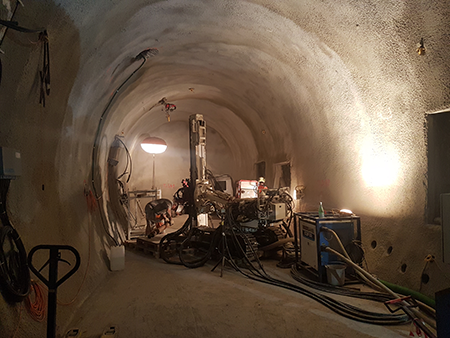ELEGANCY

|
Storing CO2 underground (Carbon Capture and Storage CCS) is one technology among others that reduces emissions above ground and therefore supports the objectives of the Energy Strategy 2050. Once the CO2 is stored, it may escape through the borehole used to pump in the CO2 or through faults in the rock above the reservoir meant to seal it. Those faults might not only influence the long-term containment of CO2, but also the occurrence of induced micro-seismicity. The presence of faults in the capturing rock therefore strongly affects the site characterization process in terms of safety and risk assessment, monitoring, verification, and with respect to the risk management plan. To study these aspects, the Swiss Seismological Service and the SCCER-SoE conduct an experiment in close collaboration with the Department of Mechanical and Process Engineering and the Institute of Geophysics at ETH Zurich, with Swisstopo and EPFL, and with scientists from Norway, the Netherlands and the UK. The experiment is part of the ELEGANCY project, which is funded by the EU and the SFOE. The main goal of the experiment is to understand the relevant processes governing movement of stored CO2 along faults, the occurrence of micro-seismicity and to contribute to an enhanced site characterization. This involves experimental work at the Mont Terri rock laboratory, where the scientists inject CO2 enriched salt water into a borehole that cuts through a major fault and monitor how the fault reacts. |
|---|---|
| Project Leader at SED | Dr. Alba Zappone |
| Funding Source | Elegancy is a project financed by Norwegian, Dutch, German, UK and Swiss national funding agencies, the European Commission, and industry. |
| Duration | 31 August 2017–31 August 2020 |
| Keywords | Induced Seismicity, Carbon Capture and Storage |
| Research Field | Induced Seismicity, Swiss Seismicity, Earthquake Hazard & Risk, Earthquake Statistics, Earthquake Early Warning, Historical Seismicity, Seismotectonics, Real-time monitoring, Engi-neer Seismology, Other |
| Website | https://www.sintef.no/en/projects/2017/elegancy-enabling-a-low-carbon-economy-via-hydrogen-and-ccs/ |
Grab et al. (2022). Fluid pressure monitoring during hydraulic testing in faulted Opalinus Clay using seismic velocity observations. J. Geophys In print .
Hopp, C., Guglielmi, Y., Rinaldi, A. P., Soom, F., Wenning, Q., Cook, P., Robertson, M., Kakurina M., Zappone A. (2021). The effect of fault architecture on slip behavior in shale revealed by distributed fiber optic strain sensing. Journal of Geophysical Research: Solid Earth. doi: 10.1002/essoar.10507120.1
Wenning Q., Madonna C., Kurotori T., Petrini C., Hwang J., Zappone A., Wiemer S., Giardini D., Pini R. (2021). Chemo-mechanical coupling in fractured shale with water and hydrocarbon flow. Geophysical Research Letters. doi: 10.1029/2020GL091357
Wenning Q., Madonna C., Zappone A., Grab M., Rinaldi A.P., Ploetze M., Nussbaum C., Giardini D., Wiemer S. (2021). Shale fault zone structure and stress dependant anisotropic permeability and seismic velocity properties (Opalinus clay, Switzerland). Journal of Structural Geology 144. doi: 10.1016/j.jsg.2020.104273
Zappone A. Rinaldi A.P., Grab M., Wenning Q., Roques C., Madonna C., Obermann A., Bernasconi S. M., Soom F., Cook P., Guglielmi Y., Nussbaum C., Giardini D., Wiemer S. (2021). Fault sealing and caprock integrity for CO2 storage: an in-situ injection experiment. Solid Earth Discussion. doi: 10.5194/se-2020-100